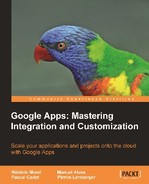While the previous chapters outlined the impacts of Google's SaaS on the infrastructure of your Information System, this chapter additionally drills down into Google's offer regarding the user desktop and experience, using Chrome (Google's browser) as a cornerstone of a Google "Workstation". Next, we'll summarize the main features of the two operating systems that Google has published: Android, currently shipped on dozens of mobile device models and Chrome OS, a revolutionary operating system that brings a small-footprint and speed to the table to meet the specific demands of a new way of working online.
Today's two most common means of access to an Information System are the user desktop and mobile devices (that is, smartphones, iPads, and so on), the latter gaining ever more popularity. At first glance, their evolution with respect to online access may seem contradictory: on the one hand, the browser has become a "one size fits all" application vis-à-vis other desktop applications; on the other hand, a handful of micro and highly specialized applications make the best use of a few high-performance web services. Google's offering regarding the user desktop and experience has been playing out within that dual and somehow conflicting motion.
Until recently, the traditional user desktop hosted collaborative tools as well as enterprise applications running proprietary, client-server protocols. While "webizing" enterprise applications dates back to over 10 years ago, "webizing" office productivity applications is much more recent. Applications like Google Documents, Google Spreadsheet, and Google Presentation from the Google Docs suite, detailed in Chapter 4, are examples of online productivity tools. For the moment, the features of such applications remain rather rudimentary and online collaborative applications do not provide either the user-friendliness or the feature completeness that their desktop counterparts do. Yet this evolution to online applications seems unavoidable as it fits into the SaaS trend embraced today by the major web players. The imminent arrival of HTML 5 and the acute competition among the major players, who all seek to provide an end-user experience for online applications as close as possible to that of desktop applications, could reinforce this tendency.
Do not kid yourself here: these changes are signs of the impending decline of the "all Windows" era on the user desktop!
Let's take a look at accessing the IS via mobile devices, such as Apple's iPhone or iPad, or smartphones running Android or Windows Mobile. All such mobile devices currently provide specific applications for email access, calendaring, and contact lists. The combination of thin applications (with user interfaces specifically tailored for mobile devices) and peformant web services is currently the approach that offers the best end-user experience.
Of particular interest in Google Apps are the web applications that were specifically designed for Apple's iPad. For enterprise use, the most relevant applications are Gmail and Google Sync.

Gmail web app, adapted for the iPad
Google Sync on the other hand synchronizes Gmail, Calendar, and Contacts to the iPad n ative applications.
G oogle's offering for the user desktop has been thought out with this complex context in mind and is comprised of:
The following schema symbolically positions the Google products within a software and hardware stack.

Google products laid out in different software and hardware layers: Google Apps in the Cloud; Google Chrome as the (essentially) lone application running on Google Chrome Operating System; mobile devices using Android as their operating system, as this point.
